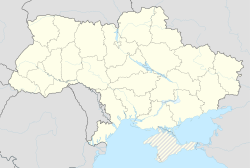Ivanhorod
|
Ivanhorod Івангород |
|
|---|---|
| Village | |

Ivanhorod road sign
|
|
| Location of Ivanhorod in Ukraine | |
| Coordinates: 48°48′10″N 29°48′09″E / 48.80278°N 29.80250°ECoordinates: 48°48′10″N 29°48′09″E / 48.80278°N 29.80250°E | |
| Country |
|
| Province |
|
| District | Khrystynivka Raion |
| Population (2001) | |
| • Total | 1,193 |
| Time zone | EET (UTC+2) |
| • Summer (DST) | EEST (UTC+3) |
| Postal code | 20040 |
| Area code | +380 4745 |
Ivanhorod or Ivangorod (Ukrainian: Іванго́род, Russian: Ивангород, Polish: Iwangród) is a village located in the Khrystynivka Raion of the Cherkasy Oblast (province) in central Ukraine, some 151 kilometres (94 mi) from Kiev.
The first traces of a settlement date back to prehistoric times, with archeological findings from the Cucuteni-Trypillian culture. In the Middle Ages Ivanhorod lay on the Chumak trade road from Kiev to Crimea. From the 13th century on, it was part of the Grand Duchy of Lithuania and subsequently, until 1791, the Polish–Lithuanian Commonwealth. The village (from 1609 owned by the ) lay on the path of the Khmelnytsky Uprising. After the Second Partition of Poland Iwanogród became part of the Russian Empire.
The Jewish community in Ivanhorod dates back to early 19th century. In 1897, the Jewish population was 442 people. During the Holocaust (on what is now Ukrainian territory), a mass murder was committed by the German Einsatzgruppe in the southern part of Ivanhorod (1942) with an unknown number of victims.
A wartime photograph showing a mother and child shot in cold blood outside the village by a German SS soldier is now considered, in the words of British journalist Robert Fisk, "one of the most impressive and persuasive images of the Nazi Holocaust." It was featured in numerous books, and at photo-exhibits both in Poland and Germany, as "precious and terrible evidence" of "the Nazi cruelties in Eastern Europe."
...
Wikipedia

